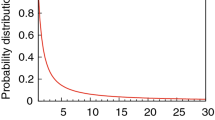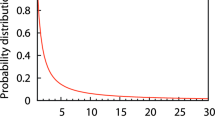Abstract
To significantly minimize the effort required to seek in new environments, it is critical to choose an effective search strategy. In mobile robotics, random search is the main search method due to the lower processing capabilities of mobile robots, which result in the detection of only local features. If you are looking for random-walking techniques that emulate social insects self-organized behaviour, then Levy’s struggle approach is very popular. Robot searches are often ineffective since the suggested methodology is very restricted. This article offers an enhanced random walking technique in which each robot’s stride size is adjusted to minimize the amount of repeated searches. To find out if the suggested approach was successful and whether it performed as an intelligent exploratory strategy, simulation tests and experiments with real robots were undertaken. The research found that the suggested approach was more successful over a wider area.




Similar content being viewed by others
References
Brenner S, Gelfert S, Rust H (2017) New approach in 3d mapping and localization for search and rescue missions. CERC2017, Karlsruhe, Germany, pp. 105
Burgard W, Moors M, Stachniss C, Schneider FE (2005) Coordinated multi-robot exploration. IEEE Trans Robot 21:376–386
Calisi D, Farinelli A, Locchi L, Nardi D (2005) Autonomous navigation and exploration in a rescue environment. In: Proceedings of the 2005 IEEE international workshop on safety, security and rescue robotics, Kobe, Japan, 6–9 June 2005. pp. 110–115
Da Silva Lubanco DL, Pichler-Scheder M, Schlechter T (2020) A novel frontier-based exploration algorithm for mobile robots. In: Proceedings of the 2020 6th international conference on mechatronics and robotics engineering, ICMRE 2020, Barcelona, Spain, 12–15 February 2020. pp. 1–5
Deng C, Liu G, Qu F (2008) Survey of important issues in multi unmanned aerial vehicles imaging system. Int J Softw Hardw Res Eng 6(10):01
Ducatelle F, Di Caro GA, Förster A et al (2014) Cooperative navigation in robotic swarms. Swarm Intell 8(1):1–33
Fang G, Dissanayake G, Lau H (2004) A behaviour-based optimisation strategy for multi-robot exploration. In: Proceedings of the 2004 IEEE conference on robotics, automation and mechatronics, Singapore, 1–4 December 2004. pp. 875–879
Ingrand F, Ghallab M (2017) Deliberation for autonomous robots: a survey. Artif Intell 247:10–44
Kei Cheang U, Lee K, Julius AA et al (2014) Multiple-robot drug delivery strategy through coordinated teams of microswimmers. Appl Phys Lett 105(8):083705
Ko J, Stewart B, Fox D, Konolige K, Limketkai B (2003) A practical, decision-theoretic approach to multi-robot mapping and exploration. In: Proceedings of the IEEE international conference on intelligent robots and systems, Las Vegas, NV, USA, 27–31 October 2003. pp. 3232–3238
Luk BL, Cooke DS, Galt S, Collie AA, Chen S (2005) Intelligent legged climbing service robot for remote maintenance applications in hazardous environments. Robot Auton Syst 53(2):142–152
Lunghi G, Marin R, Di Castro M, Masi A, Sanz PJ (2019) Multimodal human-robot interface for accessible remote robotic interventions in hazardous environments. IEEE Access 7:127290–127319
Mehmood S, Ahmed S, Kristensen AS, Ahsan D (2018) Multi criteria decision analysis (mcda) of unmanned aerial vehicles (uavs) as a part of standard response to emergencies. In: 4th international conference on green computing and engineering technologies. Esbjerg
Merino L, Caballero F, Martinez-de Dios J, Ollero A (2005) Cooperative fire detection using unmanned aerial vehicles. In: Proceedings of the 2005 IEEE international conference on robotics and automation. IEEE, pp. 1884–1889
Pitonakova L, Crowder R, Bullock S (2016) Information flow principles for plasticity in foraging robot swarms. Swarm Intell 10(1):33–63
Roberts W, Griendling K, Gray A, Mavris D (2016) Unmanned vehicle collaboration research environment for maritime search and rescue. In: 30th congress of the international council of the aeronautical sciences. International Council of the Aeronautical Sciences (ICAS) Bonn, Germany
Shakhatreh H, Sawalmeh AH, Al-Fuqaha A, Dou Z, Almaita E, Khalil I, Othman NS, Khreishah A, Guizani M (2019) Unmanned aerial vehicles (uavs): A survey on civil applications and key research challenges. IEEE Access 7:48572–48634
Sims DW, Reynolds AM, Humphries NE et al (2014) Hierarchical random walks in trace fossils and the origin of optimal search behaviour. Proc Natl Acad Sci 111(30):11073–11078
Sung Y (2019) Multi-robot coordination for hazardous environmental monitoring, Ph.D. dissertation, Virginia Tech
Waharte S, Trigoni N, Julier SJ, et al. (2009) Coordinated search with a swarm of UAVs. In: Proceedings of the sensor, Mesh and Ad Hoc communications and networks workshops. Italy, pp. 1–3
Yamauchi B (1997) Frontier-based approach for autonomous exploration. In: Proceedings of the IEEE international symposium on computational intelligence in robotics and automation, CIRA, Monterey, CA, USA, 10–11 July 1997. pp. 146–151
Yamauchi B (1998) Frontier-based exploration using multiple robots. In: Proceedings of the international conference on autonomous agents, Minneapolis, MN, USA, May 1998. pp. 47–53
Funding
The authors received no specific funding for this study.
Author information
Authors and Affiliations
Corresponding author
Ethics declarations
Conflict of interest
The authors declare that they have no conflict of interest.
Ethical approval
The manuscript has not been submitted to more than one journal for simultaneous consideration. The manuscript has not been published previously. The Research not involved human participants and/or animals.
Additional information
Publisher's Note
Springer Nature remains neutral with regard to jurisdictional claims in published maps and institutional affiliations.
Rights and permissions
Springer Nature or its licensor holds exclusive rights to this article under a publishing agreement with the author(s) or other rightsholder(s); author self-archiving of the accepted manuscript version of this article is solely governed by the terms of such publishing agreement and applicable law.
About this article
Cite this article
Vijayan, V.P., Juvanna, I., Rao, V.V.M. et al. Intelligent exploration strategy for a mobile robot to reduce the repeated searches in an unknown environment. Int J Syst Assur Eng Manag (2022). https://doi.org/10.1007/s13198-022-01776-1
Received:
Revised:
Accepted:
Published:
DOI: https://doi.org/10.1007/s13198-022-01776-1




